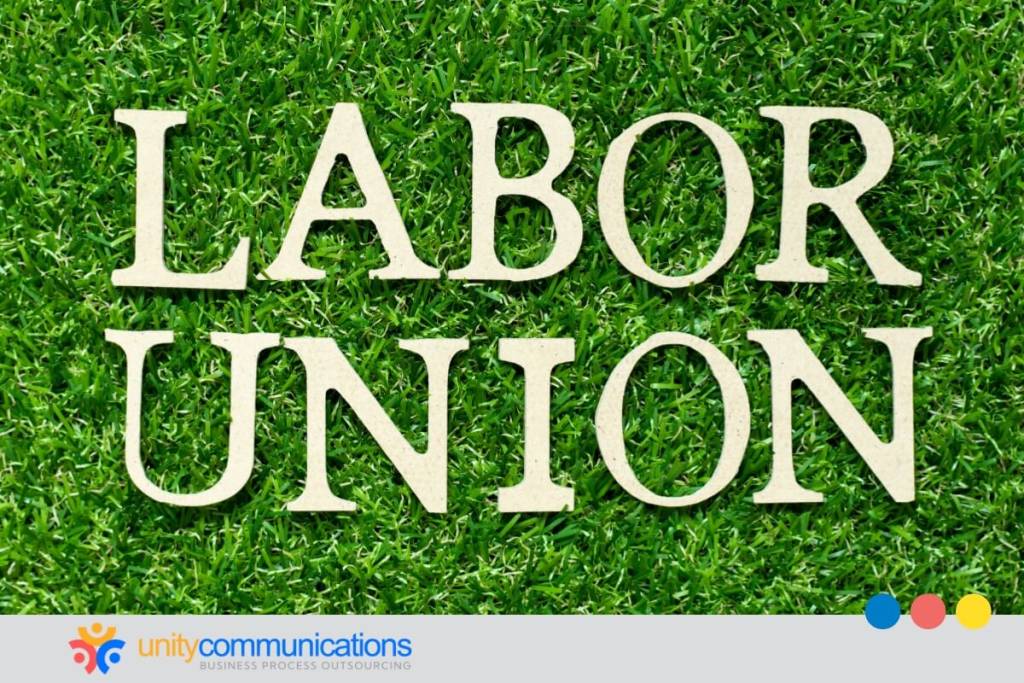Table of Contents
Businesses looking to develop a global workforce and streamline related human resources (HR) tasks leverage employer of record (EOR) services. However, this practice presents a new layer of complexity in areas with established labor unions.
If you are considering partnering with an EOR in a unionized environment, this article is for you.
It explores the dynamic and complex relationship between employer of record services and labor unions, emphasizing how a provider can affect unionized employees. Keep reading to learn tips and best practices for partnering with a provider in such conditions.
Understanding EOR services and unionized workplaces

To better understand the nature of an EOR’s relationship with labor unions, you must first distinguish the role of these two parties.
What is a labor union?
Also known as a trade union, a labor union is an organization of workers that advocate for their collective interests in the workplace. The legal framework governing labor unions varies by jurisdiction. However, these regulations typically include the right to unionize and collective bargaining agreements (CBAs).
The critical functions of labor unions include contract negotiations and member representation. They play a crucial role in the following aspects:
- Protecting employee rights. Unions ensure workers have a voice and can oppose unfair treatment or employer practices that violate safety regulations or labor laws.
- Negotiating wages and benefits. Through collective bargaining, unions negotiate with employers to secure better wages and benefits packages, such as health insurance and pensions, for their members.
- Improving working conditions. Safer workplaces, reasonable work hours, and fair treatment from employers are some of the recorded advocacies of labor unions. They might also push for legislation that improves overall labor standards.
While traditionally strong in industries such as manufacturing and transportation, global union membership rates have recently declined. Nevertheless, dedicated organizations remain significant in shaping workplace practices and advocating for worker rights.
What is an EOR?
An EOR is a third-party company that acts as your workers’ employer on record. It is similar to an information technology (IT) support outsourcing firm, except the EOR primarily handles HR processes.
The EOR manages all employment paperwork and legalities for workforce management and even provides data entry services. Payroll, taxes, benefits administration, and workers’ compensation insurance are well within the scope of its services.
The employer of record also helps ensure its client companies follow local labor laws and tax regulations by providing expertise, resources, and union information.
Partnering with a provider has many benefits:
- Reduced administrative burden
- Simplified global expansion
- Improved scalability and flexibility
- Maintained regulatory compliance
- Better access to local talent
These services and benefits make EOR widespread among businesses seeking international teams. According to Valuates Reports, the global EOR market was worth $4.29 billion in 2023 and can grow to $6.6 billion by 2030.
The impact of employer of record services on labor unions and members

Traditionally, companies directly negotiate with unions representing their employees. However, when an EOR is involved, the provider becomes the legal employer responsible for various workforce management tasks.
This conflict can be detrimental in points of interaction, such as hiring, collective bargaining, grievance procedures, and union relations. It can create distance, hindering communication and transparency.
Unionized employees must now negotiate with a third party, leaving them unsure of who the decision-makers are regarding CBAs. It also creates confusion about who is responsible for upholding the terms of agreements and addressing grievances.
Similarly, when interacting with labor unions, EOR firms face difficulties in closing transparency gaps, shifting responsibilities, and navigating the unionized workplace. In regions with a strong union presence, EOR providers can struggle with the following:
- Handling legal and regulatory scrutiny. The employer of record might face stricter labor laws and increased scrutiny from organizations and regulatory bodies in more unionized markets.
- Establishing legitimacy. Convincing unions of their commitment to worker rights and fair labor practices might become a requirement for EORs.
- Adapting processes. EOR providers may need to change their hiring, grievance, and communication processes to accommodate the complexities of a unionized environment.
The different challenges introduced by EOR services in unionized environments significantly affect trade unions and their members. Learn more about their impact below.
Effect on union members
Unionized employees might feel their rights, engagement, and overall well-being are jeopardized by the integration of EOR services. Here is an overview of how union members might think about this practice’s influence:
- Transparency concerns. The lack of transparency surrounding the employer of record’s presence in workplaces can create anxiety and distrust among labor union members. Limited visibility into the provider’s practices and blurred lines of accountability can make it harder for employees to get their concerns addressed effectively.
- Erosion of rights and benefits. One of their primary concerns is the possibility that the provider prioritizes its client company’s interest over worker well-being. In such circumstances, members struggle to enforce the terms of CBA, mainly if the EOR operates in a region with weaker labor laws.
- Declining union engagement. The introduction of the EOR can create a physical and psychological distance between unionized employees and their organization. This rift can lead to a reduced sense of connection and lower participation rates in activities. Disconnect weakens the union’s collective voice and bargaining power.
Threat to union strength
The potential lack of clarity EOR services introduce to trade unions can erode the trust between its members, the client company, and the EOR. The distance between the company and the labor union makes the following tasks difficult:
- Gathering information. Unions might struggle to obtain crucial data about the company’s financial health and plans, which are critical in securing favorable negotiation terms.
- Applying pressure. With employers of record in the middle, labor unions might find it more challenging to use tactics such as strikes or work slowdowns to exert pressure.
- Holding companies accountable. With an added layer of confusion about who is responsible for upholding CBAs, unions can have trouble seeking redress from their employer company for violations.
Additionally, companies might use EOR providers to circumvent unionization efforts altogether. For example, utilizing their services allows businesses to classify workers as independent contractors or temporary employees even when they’re not. This status makes them ineligible for union membership.
Best practices for EOR partnerships in unionized environments

Despite the complex relationship between EOR firms and trade unions, they can coexist. If you are entering a market with a strong union presence and you want to leverage EOR services, consider the following tips to ensure a smooth and successful integration:
1. Understand union agreements
Understand your unionized workforce’s CBAs to anticipate and mitigate the potential challenges EOR services might present. Note provisions related to employee classification, wages, benefits, and grievance procedures.
The document might also establish seniority-based benefits, job security measures, union dues, and representation. Determine how these rights translate when employees transition under the EOR structure.
2. Find a reputable partner
Select an employer of record with proven experience navigating labor laws and the complexities of unionized environments. Consider the following criteria:
- Expertise in understanding and adhering to the intricacies of existing CBAs
- Approaches for communicating with trade unions
- Remedial strategies and solutions for union concerns
- Compliance with relevant employment regulations in the region
Partnering with an EOR with demonstrable expertise in these three areas increases the chances of a smooth transition in a unionized workforce. It minimizes the risk of conflicts between the organization and its members.
3. Engage in strategic planning and compliance
Partnering with an experienced EOR is just the start. A well-defined partnership strategy is crucial to a successful and compliant arrangement in a unionized environment.
This plan should ensure your EOR activities comply with the union agreement and all applicable labor laws. Areas to consider include:
- Classifying employees under the EOR structure: permanent, temporary, or independent contractors
- Ensuring the EOR offers compensation and benefits that meet or exceed the standards outlined in the CBA
- Establishing a transparent process for addressing employee grievances, with defined roles for the EOR, the business, and the union
4. Maintain open communication with employees
Explain the EOR’s role to your team, discussing why your company partnered with a provider and how it affects them. Focus on the benefits this practice offers to reduce their anxieties.
Keep the communication channels easily accessible so that employees can voice their concerns. Maintain transparency throughout the partnership. Keep your team informed about relevant updates, changes, or developments.
The bottom line
The relationship between EOR firms and labor unions is nuanced. Nevertheless, you can reap the benefits of having both in your business.
By acknowledging potential challenges, prioritizing transparency, and collaborating with your provider, you can easily navigate this new landscape. These steps help you uphold union workers’ rights and respect labor agreements in the complex EOR-union relationship.
Let’s connect if you want to learn more about employer of record services and their impact on labor unions.




